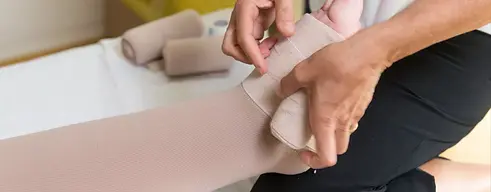Understanding Lymphedema & the Lymphatic System
Lymphedema is a chronic condition that results in swelling due to the accumulation of lymph fluid, often caused by damage or obstruction in the lymphatic system. It can affect any part of the body but is most commonly seen in the arms, legs, and post-surgical areas. Effective management is key to reducing discomfort, improving mobility, and enhancing overall well-being.
The lymphatic system is essential for fluid balance and immune function. When this system is compromised, fluid builds up in tissues, leading to swelling, discomfort, and increased risk of infection. Lymphedema can be primary (genetic) or secondary, often developing after surgery, radiation therapy, injury, or infection.
The lymphatic system plays a vital role in maintaining fluid balance and supporting immune function. When compromised, fluid can accumulate in tissues, leading to swelling, discomfort, and an increased risk of infection.
Lymphedema can be:
-
Primary (Genetic): Due to congenital factors affecting lymphatic development.
-
Secondary: Often develops after surgery, radiation therapy, injury, or infection.
Signs of Lymphoedema
It’s important to be aware of the signs of lymphoedema, especially if you’ve had surgery or radiation in the affected area. Here are some symptoms to look out for:
-
The affected limb or area may feel different—it could be achy, unusual, or have a different temperature.
-
You may notice gradual swelling in the affected limb, which typically involves one limb but can sometimes affect both.
-
The area may feel heavy or tight.
-
The skin might pucker or develop a pitting texture.
-
Skin folds at the joints can become deeper and more pronounced.
-
A positive “Stemmer’s Sign” test: if you pinch the skin on the second toe or finger of the affected limb, and the skin cannot be easily lifted and feels taut and hard, this may indicate lymphoedema.
Preventative Treatment for Lymphedema
Early intervention is key to managing lymphedema effectively. Our preventative treatments focus on:
-
Manual Lymphatic Drainage (MLD): Gentle massage techniques to stimulate lymph flow.
-
Medical Lymphatic Taping: Application of specialized tape to facilitate lymphatic drainage.
-
Compression Garment Prescription: Customized garments to maintain limb compression.
-
Instruction on Self-MLD: Teaching clients techniques for self-administered lymphatic drainage.
-
Education and Advice on Lymphedema: Providing knowledge to empower clients in managing their condition.
These treatments aim to:
-
Address subtle underlying changes in cells and tissues.
-
Break down scar tissue and fibrosis to encourage lymphatic vessel regrowth.
-
Treat radiotherapy-related scarring.
-
Redirect and stimulate lymphatic flow.
-
Non-invasively reduce seromas.
-
Educate on risk-reduction behaviors and self-treatment strategies.
Combined Decongestive Therapy (CDT)
CDT is a comprehensive approach to lymphedema management, consisting of three phases:
-
Reduction: Intensive therapy to decrease swelling.
-
Transition: Stabilizing the reduction achieved.
-
Maintenance: Ongoing practices to prevent recurrence.
Our CDT program includes:
-
Manual Lymphatic Drainage: Stimulates lymph flow to reduce swelling.
-
Multilayer Compression Bandaging: Maintains limb compression to prevent fluid accumulation.
-
Compression Garment Prescription & Fitting: Customized garments for daily use.
-
Medical Lymphatic K-Taping: Supports lymphatic function and reduces swelling.
-
Intermittent Pneumatic Compression Pump (IPC): Mechanical devices to enhance lymphatic flow.
-
Decongestive Exercises: Specific movements to promote lymph drainage.
-
Skin Care Advice: Maintaining skin integrity to prevent infections.
-
Breathing Exercises: Techniques to support lymphatic circulation.
-
Instruction on Self-MLD: Empowering clients with self-care techniques.
-
Education and Advice on Lymphedema: Comprehensive information to manage the condition effectively.
The choice of treatment depends on the duration and extent of swelling.
Goals of Treatment
Our lymphedema management aims to:
-
Reduce the volume and size of the affected limb(s) or area, transitioning from congestive swelling to a stable, maintainable state.
-
Improve tissue health in the affected area.
-
Alleviate symptoms of pain, discomfort, heaviness, and tightness.
-
Enhance mobility and overall quality of life.
Lymphedema management is an ongoing process that requires a personalised approach for long-term relief. Book a session today and take control of your well-being!
